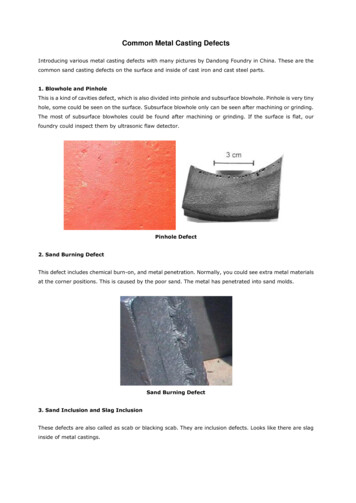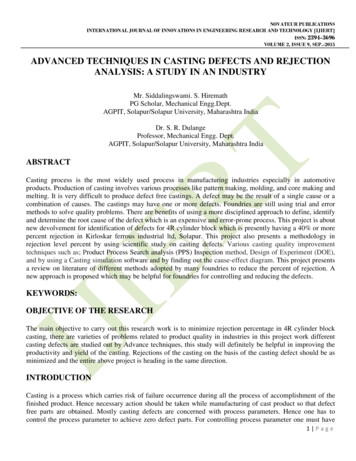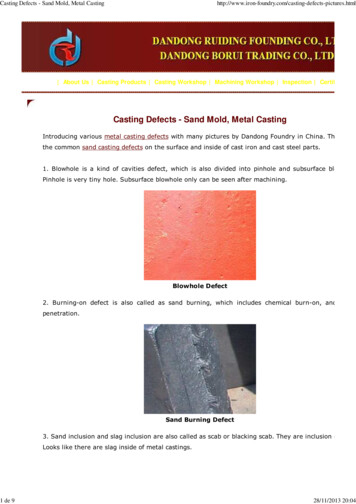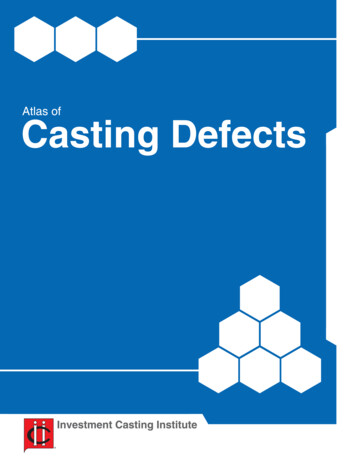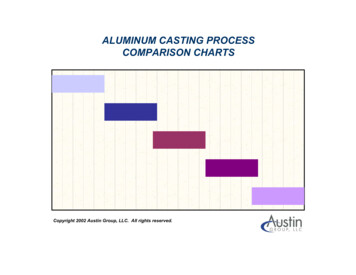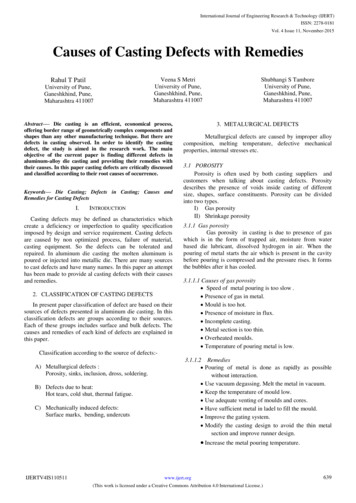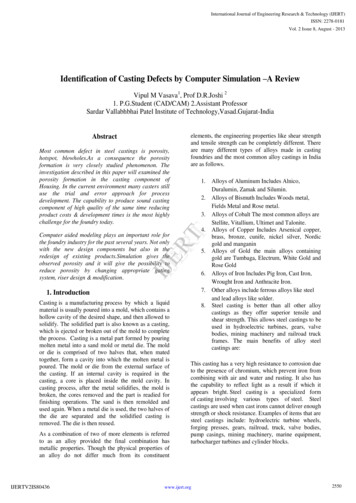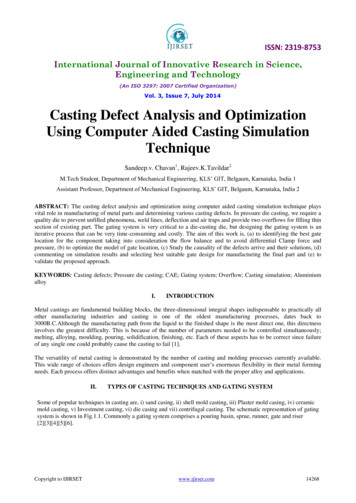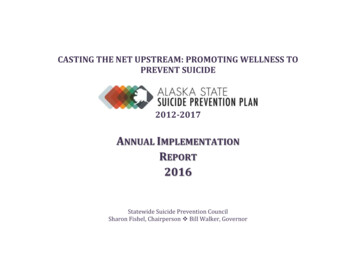
Transcription
CASTING THE NET UPSTREAM: PROMOTING WELLNESS TOPREVENT SUICIDE2012-2017ANNUAL IMPLEMENTATIONREPORT2016Statewide Suicide Prevention CouncilSharon Fishel, Chairperson Bill Walker, Governor
Statewide Suicide PreventionCouncil Members, 2016Sharon Fishel, ChairpersonSen. Anna MacKinnonSen. Berta GardnerRep. Geran TarrRep. Benjamin NageakKathryn CaselloMeghan CrowCynthia EricksonWilliam MartinBarbara FranksAlavini LataAlana HumphreyBrenda MooreLowell Sage, Jr.Randall BurnsStatewide Suicide Prevention Council StaffJ. Kate Burkhart, Executive DirectorEric Morrison, Council AssistantIntroductionTΥ SαΞα δΦΡ SβΦΠΦΡ Pί γ ΫαΦάΫ άβΫΠΦΩ ̪̍ άβΫΠΦΩ̫̎ δΞΰ ΰαΞΟΩΦΰΥ Ρ ΦΫ ʹ ͳ bythe Alaska Legislature. The Council is responsible for advising legislators and theάγ ίΫάί άΫ δΞζΰ αά ΦΪέίάγ !ΩΞΰΨΞΫΰ̊ health and wellness by reducing suicide,improving public awareness of suicide and risk factors, enhancing suicideprevention efforts, working with partners and faith-based organizations todevelop healthier communities, creating a statewide suicide prevention plan andputting it in action, and building and strengthening partnerships to preventsuicide. The Council was reauthorized by the Legislature in 2013, with a sunsetdate of June 30, 2019.Casting the Net Upstream: Promoting Wellness to Prevent Suicide is a call to action.It acknowledges the most current research and understanding of the ̍web ofΠΞβΰΞΩΦαζ̎ άΣ ΰβΦΠΦΡ Ͽ SβΦΠΦΡΞΩ Ο ΥΞγΦάί ί ΰβΩαΰ ΣίάΪ Ξ ΠάΪΟΦΫΞαΦάΫ άΣ Τ Ϋ αΦΠϼdevelopmental, environmental, physiological, psychological, social, and culturalfactors operating in complex, and often unseen, ways. Specific strategies wereidentified to achieve the goals and objectives of the suicide prevention system.These strategies come from the wisdom and experience of Alaskans. They arebased on the most current and credible data and research available. Individuals,communities, and the State of Alaska can act together to implement thesestrategies to prevent suicide.Casting the Net Upstream is a uniquely Alaskan endeavor. It is aligned with theNational Strategy for Suicide Prevention and the American Indian and AlaskaNative National Suicide Prevention Strategic Plan (2011-2015). Casting the NetUpstream encourages Alaskans to think about preventing suicide by promotingphysical, emotional, and mental wellness and strengthening personal andcommunity resilience. This is the fifth annual implementation report of suicideprevention efforts toward the Casting the Net Upstream goals.2 Page
2016 Annual ReportIn addition to the activities and efforts described in this implementation report, the Council engaged in the following activitiesin calendar year 2016: The Council held four public meetings: in person in Anchorage (January, 2016) and Fairbanks(October, 2016) and by video/teleconference in March, 2016 and June, 2016. The Council partnered with the Department of Education and Early Development to continue thecompetitive Suicide Awareness, Prevention, and Postvention [SAPP] grant program for schoolbased suicide prevention. Nine school districts were funded in 2016. The Council partnered with the Department of Education and Early Development to revise theonline eLearning suicide prevention modules, creating a condensed, shorter module for educators,and to create eLearning modules that supported delivery of training required by the Alaska Safe ΥΦΩΡί Ϋ̊ΰ !Πα ̦ʹ ͳͷ̧Ͽ The Council partnered with the Alaska Community Foundation ΞΫΡ !ΩΞΰΨΞ ΥΦΩΡί Ϋ̊ΰ Tίβΰα αάcontinue the GCI Suicide Prevention Grant Program. Nine grants were awarded in 2016, totaling 100,000. The Council (staff and/or members, often with partner organizations) made educationalpresentations at the Alaska Federation of Natives Convention, School Counselors AssociationConference, School Health and Wellness Initiative Conference, Alaska Statewide Special EducationConference, and others. Education/awareness booths and public outreach were provided at theAlaska Federation of Natives Convention and the University of Alaska Anchorage SuicidePrevention Week in 2016. The Council provided bracelets with the Careline number, Carelinemagnets, and thousands of Careline brochures for suicide prevention events sponsored bycommunity coalitions, the Alaska State Troopers, the Rotary Club of Anchorage, and others.3 Page
Casting the Net Upstream GoalsGoal 1: Alaskans Accept Responsibility for Preventing SuicideGoal 2: Alaskans Effectively and Appropriately Respond to Peopleat Risk of SuicideGoal 3: Alaskans Communicate, Cooperate, and Coordinate SuicidePrevention EffortsGoal 4: Alaskans Have Immediate Access to the Prevention, Treatment,and Recovery Services They NeedGoal 5: Alaskans Support Survivors in HealingGoal 6: Quality Data and Research is Available and Used for Planning,Implementation, and Evaluation of Suicide Prevention Efforts4 Page
Regional Suicide Prevention TeamsWhen Casting the Net Upstream was released in 2012, the Council helped to create six regional suicide prevention teams:Northern, Interior, Southwestern, Anchorage/Mat-Su, Gulf Coast, and Southeastern. These teams are made up of keystakeholders and leaders in community suicide prevention efforts. Regional teams identified and work toward state suicideprevention goals most relevant to their regions through specific action plans developed at the 2012 Statewide SuicidePί γ ΫαΦάΫ SβΪΪΦα ΞΫΡ ί ΣΦΫ Ρ Ξα αΥ ʹ ͳͶ ̍T ΫΡΦΫΤ αΥ α̎ SαΞα δΦΡ SβΦΠΦΡ Pί γ ΫαΦάΫ SβΪΪΦαϿ As local communitycoalitions have gained strength, regional teams have become less active.NORTHGoal 3INTERIORGoal 2, Goal 3,Goal 4ANCHORAGE/MAT-SUGoal 1, Goal 3, Goal 4SOUTHWESTGoal 2, Goal 3, Goal 4GULF COASTGoal 1, Goal 2, Goal 3SOUTHEASTGoal 1, Goal 3, Goal 45 Page
Suicide Rate and Number, 2015Data from the Bureau of Vital Statistics shows that 200 Alaskans died by suicide in 2015, resulting in a statewide suicide rateof .823.4127132149167140163141167171Source: Department of Health and Social Services, Bureau of Vital Statistics201422.7167201527.1200Thirty-three more Alaskans died by suicide in 2015 than in 2014. This corresponds with a national increase of 24% in suiciderates between 1999-2014, with significant increases among adults 45-64. The Centers for Disease Control and Preventionreport that national suicide rates increased 2% per year from 2006 to 2014. !ΩΞΰΨΞ̊ΰ ίΞα ί ΪΞΦΫΰ Ϊάί αΥΞΫ ΡάβΟΩ αΥ national average (13.0/100,000 in 2014). The contributing factors to the increase in suicide deaths in Alaska, and nationally,Φΰ Ξΰ ΠάΪέΩ ε Ξΰ αΥ ̍δ Ο άΣ ΠΞβΰΞΩΦαζ̎ αΥΞα ΦΫΣΩβ ΫΠ ΰ ίΦΰΨ άΣ ΰβΦΠΦΡ ϿSummary of Suicide Prevention ActivitiesThe number of community-based suicide prevention activities has grown steadily since 2010. This summary of projects andactivities provides a sample άΣ !ΩΞΰΨΞ̊ΰ γάΩγΦΫΤ ΰβΦΠΦΡ έί γ ΫαΦάΫ ΰζΰα ΪϿSuicide Prevention TrainingThe Alaska Army National Guard continues to train every service member every year in ̍!ΰΨ-Care-Escort (ACE)ϼ̎ a suicideprevention training model derived from the evidence-based Question-Persuade-Refer model. First line leaders receive ACESuicide Intervention, a more intensive skills training, at least once in their career. Alaska Army National Guard gatekeepers(behavioral health, family support, and other personnel) receive Applied Suicide Intervention Skills Training (ASIST).The Department of Education and Early Development (DEED) trained 4,992 Alaskans in FY2016 (compared to 3,079 inFY2015). All of these individuals were trained via the DEED eLearning System. Of those receiving training in FY2016, the most6 Page
popular training was Part A: Suicide Awareness, which 2,456 people completed. The second most popular eLearning modulewas Part B: Suicide Prevention, which 998 people completed.Alaska Project AWARE also supports Youth Mental Health First Aid training for adults working with young people. YouthMental Health First Aid is a nationally recognized evidence-based training that equips participants to identify, engage, andassist someone experiencing a mental health challenge or crisis. Program coordinators set a goal of training 500 people inYouth Mental Health First Aid during the second year of the program. Between October 1, 2015 and September 30, 2016,1,183 people have received Youth Mental Health First Aid training. Alaska Project AWARE exceeded its goal by 683 people.Training is available statewide. Contact Wendi Shackelford at the Alaska Training Cooperative (907.264.6224) for moreinformation.“This is the training I’ve been looking for! My little sister attempted suicide 2 years ago and I didn’t recognize the symptomsbecause they were different than the typical adult ones. Thank you for sharing this knowledge!”– Youth Mental Health First Aid Training participant, 2016“This course was excellent and should be required for mental health workers and educators in Alaska where the problem ofsuicide is predominant.”– Youth Mental Health First Aid Training participant, 2016Suicide Prevention OutreachGovernor Bill Walker formed a cabinet-level suicide prevention work group in 2016, chaired by Department of Health andSocial Services Commissioner Valerie Davidson. In addition to DHSS, members of the workgroup included representativesfrom the departments of Education, Labor, Public Safety, Corrections, Military and Veterans Affairs, and boards andcommissions such as the Statewide Suicide Prevention Council and the Council of Domestic Violence and Sexual Assault.7 Page
Inspired by other established prevention programs and materials, the work group developed awallet card with three steps to take if one is worried someone might be at risk of self-harm. Thegroup began distributing the cards to state employees and to the public in state offices in FiscalYear 2017. The card identifies three steps that individuals can take to help intervene ifsomeone is at risk of self-harm that form the acronym, ASK. They are: AΰΨ ΦΣ ζάβ̊ί δάίίΦ Ρ ΞΟάβα ΰάΪ άΫ ̊ΰ ΰΞΣ αζϾ ̍!ί ζάβ αΥΦΫΨΦΫΤ άΣsuicide?̎Share that you care about the person.Keep the person company while you call Careline together.During Suicide Prevention Awareness Month (September 2016), Governor Walker and Lt.Governor Mallott emailed all state employees encouraging them to learn more about suicideprevention, to take and share the ASK Card, and to get involved in suicide prevention. The Division of Behavioral Healthdeveloped a one-hour ASK prevention training for state employees that it began offering in September, 2016 in Juneau,Anchorage, and Fairbanks. The State of Alaska has added a link to Careline on state web pages. It also produced a publicservice message to run in public Department of Motor Vehicle offices.The Statewide Suicide Prevention Council partnered with the Alaska Federation of Natives (AFN) on an outreach initiative atαΥ ʹ ͳ ! άΫγ ΫαΦάΫ ΦΫ ΞΦίΟΞΫΨΰ ΦΫ ί ΰέάΫΰ αά Ξ Ρ ΞαΥ Οζ ΰβΦΠΦΡ Ξα αΥ έί γΦάβΰ ζ Ξί̊ΰ ΠάΫγ ΫαΦάΫ ΦΫ !ΫΠΥάίΞΤ Ͽ !planning team of Council members and staff, AFN officials, and tribal behavioral health professionals developed a five-tieredapproach that included a Healing Ceremony, a Wellness Room, a convention resolution, an information booth, and a socialmedia campaign.Former Council Chairman and Tlingit Elder William Martin opened the 2016 AFN Convention with a speech on suicideprevention that focused on healing and wellness. Athabascan singer Travis Cole followed with a song written and performed inhis native language about his friend that died by suicide. The Healing Ceremony concluded with a prayer by Council memberand pastor Lowell Sage.8 Page
The Council partnered with Southcentral Foundation, TananaChiefs Conference, and Southeast Alaska Regional HealthConsortium to host a Healing Room during the AFN Convention. Itwas staffed by clinicians and volunteers to help connectindividuals with services if they were experiencing mental healthemergencies or were at risk of self-harm. The group coordinatedwith the Fairbanks police and fire departments in the case ofsomeone experiencing an acute emergency.Council members and staff hosted an information booth at theAFN Convention and gave out hundreds of suicide preventionbrochures, magnets, pens, and other resources. The Councilcommissioned 1,000 limited edition bandanas by Rampart HighSchool student-artist Natawnee Wiehl that included the Carelinenumber and a message of healing and were distributed at theinformation booth. Prior to the convention, the Council workedwith Northwest Strategies to develop a social media campaign thatincluded images and videos that were distributed on various socialmedia platforms throughout the convention. The main focus of uicidealaska.org and highlight the Statewide SuicidePrevention Plan goals and strategies.Photo by Loren Holmes/Alaska Dispatch News(From left to right) Council members Cynthia Erickson, Alavini Lata,Sen. Berta Gardner, Lowell Sage, Meghan Crow, and Robert SandersonJr., and Athabascan singer Travis Cole listen while Council memberWilliam Martin addresses the 2016 AFN Convention during a HealingCeremony on Thursday, October 20, 2016.Community Suicide PreventionThe Anchorage Suicide Prevention Coalition continues to support suicide prevention eΣΣάίαΰ ΦΫ !ΩΞΰΨΞ̊ΰ ΩΞίΤ ΰα ΠΦαζ. In 2016,the Anchorage Coalition attended numerous events to provide resources, including the Out of Darkness Walk in May,International Survivor of Loss Day in November, as well as supported numerous trainings across the community. The JuneauSuicide Prevention Coalition continues to support suicide prevention in the Juneau School District, including the Sources ofStrength Program in all three high schools with plans of expanding it into middle schools. The Coalition also continues tosupport Signs of Suicide at all three high schools. The Juneau Coalition hosted a 2-day summit at the University of AlaskaSoutheast in June of 2016 that was well attended by students as well as the greater community.9 Page
ί δ̊ΰ άβΫΡΞαΦάΫ in Bethel continues to promote suicide prevention awareness, youth development, and wellness. In 2016, ί δ̊ΰ άβΫΡΞαΦάΫ partnered with Iditarod racers Mike Williams, Jr. and Pete Kaiser, and with Iron Dog racers and DonlinGold, to promote suicide prevention and share materials during races. For the fifth year, ί δ̊ΰ άβΫΡΞαΦάΫ ΰέάΫΰάί Ρ ΞΫΡέίάΡβΠ Ρ αΥ ̍PΩΞΠ άΣ Ϊάίζ̎ at the Cama-I Dance Festival. The room is a safe place for people to talk and remember lovedones that have died by suicide. It also supports healthy youth activities and public awareness events, including the 6 th annualWalk For Life and 5K Run and sponsoring two students to travel to California to attend a wrestling camp.The Division of Behavioral Health (DBH) funded 19 comprehensive behavioral health prevention grantees in 2016. Thesegrantees are all community coalitions focused on data-driven prevention activities:Nome Regional Wellness ForumNorth Slope Substance Abuse Prevention & Intervention CoalitionFairbanks Wellness CoalitionNulato Wellness CoalitionHooper Bay Community Planning GroupAlaska Alternative Schools CoalitionBethel Healthy Families CoalitionThrive Mat-SuAnchorage Communities Mobilizing for Change on AlcoholSpirit of Youth CoalitionAnchorage Youth Development CoalitionKenai Prevention CoalitionSeward Prevention CoalitionChenega Bay & Tatitlek Community CoalitionJuneau Suicide Prevention CoalitionKetchikan Wellness CoalitionPrince of Wales Behavioral Health CoalitionPetersburg Prevention CoalitionWrangell Early Prevention Coalition 150,000 134,942 260,000 95,848 150,000 350,000 150,000 260,960 264,458 257,092 342,473 150,680 150,000 149,853 284,000 150,000 224,802 123,480 95,582Grantee coalitions are required to address behavioral health issues αΥΞα ΠάΫαίΦΟβα αά αΥ ̍δ Ο άΣ ΠΞβΰΞΩΦαζ̎ Σάί ΰβΦΠΦΡ through strict adherence to the Strategic Prevention Framework prevention model from SAMHSA. Coalitions began with10 P a g e
assessment of community needs, readiness, and resources related to behavioral health prevention. Based on the results ofthose community assessments, the coalitions will implement at least one environmental strategy (community-level preventionactivities) and collect, monitor, and report local data related to grant activities. Coalitions that had developed and/orimplemented suicide prevention strategies under past DBH prevention grant programs ̝ strategies which may or may notalign with the new grant requirements ̝ have sought funding from local and other organizations to maintain their efforts. TheStatewide Suicide Prevention Council sponsored a Community Café event at the 2016 DBH Annual Grantee Meeting whereCouncil members and staff interacted with and received feedback from grantees on the Strategic Prevention Frameworkprocess and the major issues facing each community. The Council will use the information gathered from the grantees andincorporate it into the revision of the Statewide Suicide Prevention Plan that will take place over the course of 2017.Community coalitions, the Alaska chapter of the American Foundation for Suicide Prevention, and local organizations hostedsuicide prevention awareness walks/runs across the state. The University of Alaska Anchorage hosted multiple events forSuicide Prevention Awareness Month (September). The theme of these suicide prevention activities was CommunityConnectedness.The Alaska Community Foundation ΞΫΡ αΥ !ΩΞΰΨΞ ΥΦΩΡί Ϋ̊ΰ Tίβΰα ΣβΫΡ Ρ 9 ΤίΞΫα ΰ ΦΫ ʹ ͳ Σάί αΥ SβΦΠΦΡ Pί γ ΫαΦάΫGrant Program, totaling 100,000. Grants were awarded to:AK Child & Family ( 12,500)Alaska Native Tribal Health Consortium ( 5,000)Covenant House Alaska ( 15,000)Juneau Youth Services ( 8,000)Kenai Peninsula Borough School District ( 15,000)Native Village of Paimiut ( 15,000)Native Village of Tununak ( 9,500)Perseverance Theatre, Inc. ( 5,000)Wellspring Revival Ministries ( 10,000)TΥ !ΩΞΰΨΞ άίΤ α άα άΞΩΦαΦάΫ̊ΰ ΣάΠβΰ Φΰ άΫ ΰαΞα δΦΡ ΠάΩΩΞΟάίΞαΦάΫϼ ΠάΪΪβΫΦαζ άβαί ΞΠΥ ΞΫΡ ΡβΠΞαΦάΫϼ and strategicpartnerships that result in the identification of gaps in services, enhancement of service delivery, minimization of duplicationof programs and maximization of existing funding on behalf of Service Members, Veterans and Families (SMVF) living inAlaska. The organizational structure of the Forget Me Not Coalition includes alliances comprised of civilian and military servicepartners designated to help mitigate the negative effects associated with military service. Alliances that have been formed are:Behavioral Health/Health; Faith and Service; Finance/Employment and Transition; Legal; and Child and Youth. Coalitionmembers provided suicide prevention training for 3,404 people in community organizations, active duty military, and lawenforcement focused on supporting Service Members, Veterans and Families.11 P a g e
School-Based Suicide PreventionFY2016 was the fourth year of the Suicide Awareness, Prevention, and Postvention [SAPP] grant program, implemented by theDepartment of Education and Early Development [DEED] in partnership with the Council. Nine school districts were funded toprovide evidence-based suicide prevention in their high schools. All school districts receiving SAPP grants provide services tostudents at-risk of suicide. Seven of the school districts have received funding in the past. The Lower Yukon and KenaiPeninsula Borough School Districts are new grantees.The Juneau, Anchorage and Mat-Su Borough School Districts areBering Straits School District continuesimplementing suicide prevention programs in alternative schools. Theto see success in peer leadership modelPetersburg School District is partnering with a local behavioral healthprovider αά εέΞΫΡ ΰαβΡ Ϋαΰ̊ ΞΠΠ ΰΰ αά Ϊ ΫαΞΩ Υ ΞΩαΥ ΰ ίγΦΠ ΰϿ TΥ “We continue to learn that we are making a difference in theLower Yukon and Bering Straits School Districts base their suicidelives of the students. They, in turn, are making a positiveprevention efforts on peer leadership and support.difference in their communities. We had a very successfulYouth Leaders training. We feel it was probably the best.The Youth Leaders Program is making a difference in the livesof people in our region. In a recent survey, 92% of youthreported to have intervened with at least three people. Themost common problems encountered by Youth Leaders weresadness, depression, schoolwork and bullying. This program ismaking our communities stronger by providing protectivefactors that reduce suicide that increases overall wellness inour villages.” ̊ΰ Safe, Supportive, and Successful Schools Initiative is supportedby the Positive Behavioral Interventions and Supports, School Safetyand Health, Youth Risk Behavior Survey, Suicide Awareness andPrevention, and eLearning efforts, among others. This comprehensiveΞέέίάΞΠΥ ΣβίαΥ ίΰ αΥ άΟΧ ΠαΦγ ΰ άΣ !ΩΞΰΨΞ̊ΰ ζάβαΥ ΰβΦΠΦΡ έί γ ΫαΦάΫefforts and the goals of Casting the Net Upstream. DEED, with thesupport of a grant from the Department of Health and Social Services,continued the Promoting Health Alternative Schools and CommunityPartnerships Initiative in 2016.The You Are Not Alone youth QPR training and support program,founded by former Council member Kathryn Casello and supported by the DBH and DEED, provided fewer trainings in 2016due to reduced funding. Even so, You Are Not Alone supported more than a dozen events and trainings across the state in2016.12 P a g e
Increasing Access to Prevention, Treatment, and Recovery ServicesWith a grant from SAMHSA, DEED has funded mental health professionals in the Anchorage, Mat-Su Borough, and KenaiPeninsula Borough school districts through Project AWARE. These counselors provide immediate access to mental healthassessment, services, and referrals for students at risk. School-based mental health professionals funded by Alaska ProjectAWARE made almost 7,000 student contacts during the second year of the program, providing direct student services atschools in a variety of settings (individual, small group, large group, classroom, family, etc.).Project AWARE includes the specific objective of increasing the number of students referred to and accessing communitybehavioral health services by 25%. In other communities, long-standing collaborations help meet the behavioral healthprevention, treatment, and recovery needs of students. Family Centered Services in Fairbanks and Juneau Youth Servicespartner with local school districts to offer mental health and substance abuse screening and treatment services to students atrisk of suicide or severe emotional disturbances (these projects are supported by grants from the DEED SAPP program andDBH).Alaska Native Tribal Health Consortium funds a Rural Aftercare Coordinator at Alaska Psychiatric Institute. This coordinatorsupports patients admitted from rural Alaska connect with treatment and support services in their home community afterdischarge. This culturally relevant form of discharge and transition support is designed to increase the likelihood of success inthe home community and reduce the need for repeat acute hospitalizations.In Fiscal Year 2016, 42,123 Medicaid recipients received behavioral health services in Alaska.1 The majority of treatmentservices for acute mental health and substance use disorders were provided to Medicaid recipients by community behavioralhealth centers, inpatient and residential treatment centers, and outpatient hospitals. Primary care providers also served manyMedicaid recipients with mental health and substance use disorders.Supporting SurvivorsBereavement support groups and suicide surγΦγάίΰ̊ Τίάβέΰ Ξί ΞγΞΦΩΞΟΩ ΦΫ !ΩΞΰΨΞϿ The Mat-Su Coalition for SuicidePrevention host survivors support groups twice a month. ΞΦίΟΞΫΨΰ ΪάίΦΞΩ άΰέΦαΞΩ̊ΰ άΰέΦΠ PίάΤίΞΪ Υάΰαΰ αδά ΰβέέάίαgroups each month.1Service utilization data is from Medicaid claims information downloaded and analyzed September 2-4, 2016. The data includes behavioral health claims with a servicedate in FY16 where the payment date was in FY16 or by the date that the claims data were downloaded.13 P a g e
Data and Research DevelopmentThe Arctic Resource Center for Suicide Prevention (ARCSP) was founded in 2013 by a group of survivors of a loss to suicideand survivors of attempted suicide in Fairbanks. It is a resource center and a catalyst for research on suicide in the Arctic. In2015, the ARCSP partnered with an ecumenical group of clergy leaders to begin developing a faith-based suicide prevention.The curriculum was delivered at the Alaska Bible College in Palmer in January, 2016. For more information about the ARCSP,call Dr. James Wisland at (907) 750-5605.The Alaska Mental Health Board and Advisory Board on Alcoholism and Drug Abuse provided analysis and reporting on theresults of the Adverse Childhood Experiences ̦! ΰ̧ ήβ ΰαΦάΫΰ ΞΰΨ Ρ ΦΫ !ΩΞΰΨΞ̊ΰ ΞΫΫβΞΩ Behavioral Risk factor SurveillanceSystem (BRFSS) survey. The BRFSS is an annual survey of adults conducted in every state. It is administered by the Division ofPublic Health in Alaska and is an invaluable source of information about the health behaviors and quality of life of Alaskans.The survey included ACEs quesαΦάΫΰ Σάί αΥ ΣΦίΰα αΦΪ ΦΫ ʹ ͳ ϼ ΠάΩΩ ΠαΦΫΤ ΡΞαΞ ΞΟάβα !ΩΞΰΨΞΫΰ̊ εέ ίΦ ΫΠΦΫΤ ΞΡγ ίΰ ΠΥΦΩΡΥάάΡevents such as the death of a parent, child abuse and neglect, childhood sexual abuse, parental substance abuse, and othertraumatic experiences. This data has already begun to inform statewide suicide prevention efforts, as these sorts of traumatic γ Ϋαΰ ΠάΫαίΦΟβα αά αΥ ̍δ Ο άΣ ΠΞβΰΞΩΦαζ̎ άΣ ΰβΦΠΦΡ ̦Ξΰ δ ΩΩ Ξΰ ΪΞΫζ άαΥ ί Υ ΞΩαΥ ΞΫΡ ΰάΠΦΞΩ ΠάΫΰ ήβ ΫΠ ΰ̧ϿThe 2015 BRFSS data (released in 2016) on ACEs in Alaska showed that 65% of Alaskan adults surveyed had experienced atleast one ACEs, and 21% had experienced four or more ACEs. Alaskans reporting four or more ACEs were far more likely toί έάία ̍ΣΞΦί αά έάάί̎ έΥζΰΦΠΞΩ Υ ΞΩαΥϼ ΞΫΡ δ ί Ϊάί ΩΦΨ Ωζ αά ί έάία ̍Σί ήβ Ϋα Ϊ ΫαΞΩ ΡΦΰαί ΰΰ̎ ΞΫΡ ΥΦΤΥ ί ΫβΪΟ ίΰ άΣ ΡΞζΰ άΣpoor mental health each month. A complete overview of the data and analysis is available online. For more information aboutthe ACEs question module, contact Patrick Sidmore, Health Systems Planner II, Alaska Mental Health Board and AdvisoryBoard on Alcoholism and Drug Abuse at (907) 465-8920.Note About the Implementation ReportThis report highlights key strategies where progress was achieved in 2016. In response to constituent input, an appendix hasbeen added with a scorecard of all the Casting the Net Upstream performance measures. For information about a specificproject, or to share another suicide prevention program with the Council and its partners, contact Eric Morrison at (907) 465 6518.14 P a g e
Goal 1: Alaskans Accept Responsibility for Preventing SuicideStrategy 1.3 Alaskan youth seek out healthy and appropriate relationships with role models in their communityIndicator:1.3.a Traditional high school students participating in organized after-school activities 2 or more days aweek: 54.9% (YRBS, 20152) — compare to 44% in 20111.3.b. Alternative high school students participating in organized after-school activities 2 or more days aweek: 35.9% {YRBS, 2015) ̟ compare to 35.1% in 2011Children and youth who are engaged in extracurricular and after-schoolactivities have the opportunity to build and strengthen the developmentalassets needed for healthy development. Caring and appropriaterelationships with adults outside of a ζάβΫΤ έ ίΰάΫ̊ΰ ΣΞΪΦΩζ ΥΞγ ΰΦΤΫΦΣΦΠΞΫα ΦΫΣΩβ ΫΠ άΫ αΥΞα ζάβαΥ̊ΰ Ρ γ ΩάέΪ Ϋα ΞΫΡ ί ΰΦΩΦ ΫΠ Ͽ WΥ Ϋyoung people engage in sports programs, music programs, churchactivities, scouting, or community programs like Big Brothers Big Sisters,they connect with strong role models and build a sense of connectednesswith their community.Boys and Girls Clubs of Alaska offered homework help, sports, nutrition,arts, and leadership programs to 2,975 young people each day in 32communities, most of which were in rural Alaska. The Juneau After SchoolCoalition, established in 2009, is an example of a community coalition thatprovides critical afterschool programs like the volunteer supported BAM!(Body & Mind) After School program to engage middle-schoolers inpositive, healthy activities.(From left to right) Governor Bill Walker, student artistNatawnee Wiehl from Rampart, and Council member CynthiaErickson at 2016 AFN Convention.The Youth Risk Behavior Survey [YRBS] is part of a national epidemiological surveillance system established by the Centers for Disease Control andPrevention.215 P a g e
Goal 2: Alaskans Effectively and Appropriately Respond to People at Risk of SuicideStrategy 2.2 Alaskans know about Careline and other community crisis lines, and can share that information with others.Indicators: 2.2.a. Number of calls to Careline annually: 15,323 ̟ compare to 13,558 in 2015Careline Φΰ !ΩΞΰΨΞ̊ΰ ΫΞαΦάΫΞΩΩζ ΞΠΠί ΡΦα Ρ ΰαΞα δΦΡ ΰβΦΠΦΡ έί γ ΫαΦάΫ ΞΫΡ ΠίΦΰΦΰ ΠΞΩΩ ΩΦΫ Ͽ WΥΦΩ Careline activity, includingincoming and outgoing calls and texts, was relatively stable from 2012 through the second quarter of 2014. Contacts sincethen have more than doubled. More Alaskans are reaching out for help, due in large part to coordinated and consistent mediaand outreach efforts statewide. Careline strives to keep up with this demand, but the number calls transferred to the NationalSuicide Prevention Lifeline network is increasing.Careline received 15,323 calls ̝ including hang ups and wrong numbers ̝ in 2016, a 13% increase in the number of callscompared to 2015. Of these, 13,851 were answered by trained staff in Fairbanks. The remainder were transferred to theNational Suicide Prevention Lifeline because Careline staff were already responding to a call.Careline tracks the nature of the calls received (domestic violence, parenting, suicide, loneliness, etc.), and reports that the vastmajority of callers disclose a mental health and/or substance use disorder.
Conference, School Health and Wellness Initiative Conference, Alaska Statewide Special Education Conference, and others. Education/awareness booths and public outreach were provided at the Alaska Federation of Natives Convention and the University of Alaska Anchorage Suicide Prevention Week in 2016.


